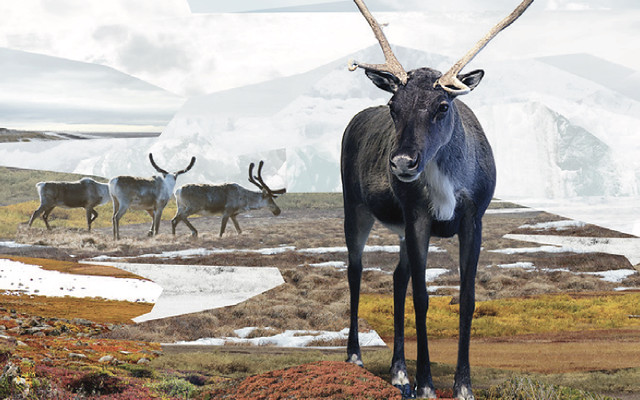The reindeer (Rangifer tarandus), also known as the caribou in North America,[3] is a species of deer with circumpolar distribution, native to Arctic, sub-Arctic, tundra, borealand mountainous regions of northern Europe, Siberia and North America.[2] This includes both sedentary and migratory populations. Rangifer herd size varies greatly in different geographic regions. The Taimyr herd of migrating Siberian tundra reindeer (R. t. sibiricus) in Russia is the largest wild reindeer herd in the world,[4][5] with numbers varying between 400,000 and 1,000,000. What was once the second largest herd is the migratory boreal woodland caribou (R. t. caribou) George River herd in Canada, with former variations between 28,000 and 385,000. As of January 2018, there are fewer than 9,000 animals estimated to be left in the George River herd as reported by the Canadian Broadcasting Corporation.[6] The New York Times in April 2018 similarly reported of the disappearance of the only herd of southern mountain caribous in the lower 48 states, with an expert calling it “functionally extinct” after the herd’s size dwindled to a mere three animals.[7]
Rangifer varies in size and colour from the smallest, the Svalbard reindeer, to the largest, the boreal woodland caribou. The North American range of caribou extends from Alaskathrough the Yukon, the Northwest Territories and Nunavut into the boreal forest and south through the Canadian Rockies and the Columbia and Selkirk Mountains.[8] The barren-ground, Porcupine and Peary caribou live in the tundra, while the shy boreal woodland caribou prefer the boreal forest. Two major subspecies in North America, the Porcupine caribou and the barren-ground caribou, form large herds and undertake lengthy seasonal migrations from birthing grounds, to summer and winter feeding grounds in the tundra and taiga. The migrations of Porcupine caribou herds are among the longest of any terrestrial mammal.[8] Barren-ground caribou are also found in Kitaa in Greenland, but the larger herds are in Alaska, the Northwest Territories and Nunavut.[9]
While overall widespread and numerous,[2] some of its subspecies are rare and at least one has already become extinct, the Queen Charlotte Islands caribou of Canada.[10][11]Historically the range of the sedentary boreal woodland caribou covered over half of present-day Canada[12]and into the northern States in the U.S.. Woodland caribou have disappeared from most of their original southern range and were designated as threatenedin 2002 by the Committee on the Status of Endangered Wildlife in Canada(COSEWIC).[13] Environment Canada reported in 2011 that there were approximately 34,000 boreal woodland caribou in 51 ranges remaining in Canada.(Environment Canada, 2011b).[14] Siberian tundra reindeer herds are in decline. For this reason, Rangifer tarandus is considered to be vulnerable by the IUCN.
Human dependence on caribou/wild reindeer began in the Middle Pleistoceneperiod.[15]:17 Arctic peoples, such as the Caribou Inuit, the inland-dwelling Inuit of the Kivalliq Region in northern Canada, the Caribou Clan in the Yukon, the Inupiat, the Inuvialuit, the Hän, the Northern Tutchone and the Gwich’in (who followed the Porcupine caribou for millennia), have depended on them for food, clothing and shelter. Hunting of wild reindeer and herding of semi-domesticated reindeer (for meat, hides, antlers, milk and transportation) are important to several Arctic and sub-Arctic peoples.[16]
The Sami people (Laplanders), have also depended on reindeer herding and fishing for centuries.[17]:IV[18]:16[17]:IV In Lapland, reindeer pull pulks.[19]
Male and female reindeer can grow antlers annually, although the proportion of females that grow antlers varies greatly between population and season.[20] Antlers are typically larger on males.
In traditional festive legend, Santa Claus’s reindeer pull a sleigh through the night sky to help Santa Claus deliver gifts to good children on Christmas Eve.
(From Wikipedia, June 2018)




